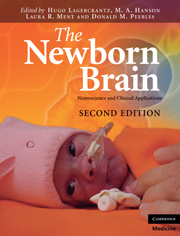Book contents
- Frontmatter
- Contents
- List of contributors
- Preface to the First Edition
- Preface to the Second Edition
- 1 Reflections on the origins of the human brain
- Section 1 Making of the brain
- Section 2 Sensory systems and behavior
- 9 Development of the somatosensory system
- 10 Principles of endogenous and sensory activity-dependent brain development: the visual system
- 11 Fetal and neonatal development of the auditory system
- 12 Newborn behavior and perception
- Section 3 Radiological and neurophysiological investigations
- Section 4 Clinical aspects
- Section 5 Follow-up
- Section 6 Consciousness
- Index
- Plate section
- References
12 - Newborn behavior and perception
from Section 2 - Sensory systems and behavior
Published online by Cambridge University Press: 01 March 2011
- Frontmatter
- Contents
- List of contributors
- Preface to the First Edition
- Preface to the Second Edition
- 1 Reflections on the origins of the human brain
- Section 1 Making of the brain
- Section 2 Sensory systems and behavior
- 9 Development of the somatosensory system
- 10 Principles of endogenous and sensory activity-dependent brain development: the visual system
- 11 Fetal and neonatal development of the auditory system
- 12 Newborn behavior and perception
- Section 3 Radiological and neurophysiological investigations
- Section 4 Clinical aspects
- Section 5 Follow-up
- Section 6 Consciousness
- Index
- Plate section
- References
Summary
Introduction
Traditionally, the behavior of human newborns has been considered to be essentially reflexive over the first few weeks of life. However, more recently evidence has accumulated to indicate that newborns are already well equipped to acquire and learn information rapidly. In addition, through prenatal learning and other mechanisms, newborns are biased to orient and attend to specific types of information that will become of high relevance to their future learning and survival. In this chapter, we begin by outlining evidence for the learning abilities of newborns, before discussing some domains for which there is evidence that newborns have specific biases or abilities.
Two abilities that are already present at birth are orienting to novelty and habituation to repeated stimuli. These processes can be revealed by registering changes in newborns' looking and sucking behavior. Cardiac and brain activity measures, when incorporated in careful experimental design, may also shed light on newborns' brain function.
Orienting
Orienting towards new stimuli is not only essential for the survival of any organism, it is also a key prerequisite of learning. Therefore, it is of primary importance for neonates. The orienting reflex is a combination of overt and covert responses associated with searching for and preferential processing of new information (Pavlov, 1927; Sokolov, 1963; Sokolov et al., 2002).
- Type
- Chapter
- Information
- The Newborn BrainNeuroscience and Clinical Applications, pp. 185 - 198Publisher: Cambridge University PressPrint publication year: 2010

